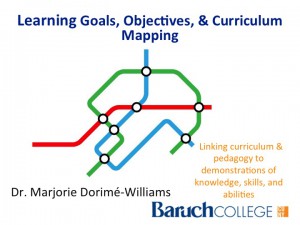Best Practices for Academic Assessment Dr. Marjorie Dorimé-Williams
Category Archives: Fellows’ Corner
Learning Goals, Objectives, & Curriculum Mapping
Curriculum mapping by Dr. Marjorie Dorimé-Williams
The Key to a Good-Paying Job Is…Microsoft Excel?
The Key to a Good-Paying Job Is…Microsoft Excel? (From The Wall Street Journal ,Mar 5, 2015) By LAUREN WEBER
Want a job that promises a living wage and a good shot at a middle-class life? Learn Microsoft Excel and other basic digital skills.That’s the conclusion of a report released Thursday by Burning Glass Technologies, a labor-market analysis firm that reviewed millions of job postings to understand which skills companies expect workers to have. The report focuses on middle-skill jobs – roles that require a high school diploma but not necessarily a college degree. Continue reading
Learn Microsoft Excel and other basic digital skills.That’s the conclusion of a report released Thursday by Burning Glass Technologies, a labor-market analysis firm that reviewed millions of job postings to understand which skills companies expect workers to have. The report focuses on middle-skill jobs – roles that require a high school diploma but not necessarily a college degree. Continue reading
How some professions use math?
QR in Profession
Accountants assist businesses by working on their taxes and planning for upcoming years. They work with tax codes and forms, use formulas for measuring interest, and spend a considerable amount of energy organizing paperwork.
Agriculturists determine the proper amounts of fertilizers, pesticides, and water to produce bountiful foods. They must be familiar with mixture problems.
Architects design buildings for structural integrity and beauty. They must know how to calculate loads for finding acceptable materials in design.
Biologists study nature to act in concert with it since we are so closely tied to nature. They use proportions to count animals as well as use statistics/probability.
Chefs use quantitative tools to plan schedules, balance costs against value of ingredients, and monitor nutritional value of meals.
Say it with a graph
Say it with a graph (A copy of this post is available for download in Microsoft Word format: Click Here)
Creating and interpreting graphs of numerical relationships can be intimidating for students. While they may not be expected to create graphs in their every day life, they will certainly be expected to understand graphs they are presented with by advertisers or on the news.
This activity is intended to demystify the graph and help students gain an understanding of the underlying numerical relationships behind them. We will achieve this by removing the “scary part” … the numbers.
Suggested Use: The activity presented below could be used as a 5-min. warm up in class or as a creative extra-credit task.
At their core, graphs are just pictures.
Correlation VS Causation
 Yes, yes, we know
Yes, yes, we know
….Correlation DOES NOT equal causation, but deciphering all of the data we’re bombarded with everyday can be challenging.
Here are a few examples of correlation vs. causation I dug up, in order of absurdity. Some examples are so ridiculous that you should recognize them immediately as miss-use of correlation vs. causation data, but others will make you think a little more about what data we need to make conclusions about what is really going on.
Consumer Math
Here are a few articles I’ve found that give us a glimpse into the (sad) state of consumer math in America, and what we can do about it.
 This article on NBC News sums up a situation I’m sure we’ve all found ourselves in:
This article on NBC News sums up a situation I’m sure we’ve all found ourselves in:
“Think about the last time you had lunch with four or more friends. What happened when the bill came? Everyone pulled out calculators, there was a lot of murmuring and head scratching and still some of your friends just ended up throwing down a $20 bill and hoping for the best. Now, imagine that crowd in a car dealership or with a mortgage broker. They wouldn’t stand a chance.”
Why are these situations always so difficult? This article from the Atlantic sums up some typical issues consumers have with math. The intro gives a great example:







